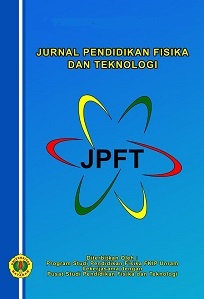The Development of Light and Optics Learning Multimedia Oriented Students Creative Thinking Skill
DOI:
10.29303/jpft.v8i2.4335Published:
2022-12-23Issue:
Vol. 8 No. 2 (2022): July-DecemberKeywords:
Multimedia, Learning, Light and Optics, Creative ThinkingArticles
Downloads
How to Cite
Downloads
Metrics
Abstract
- The purpose of this research is to develop learning multimedia on light materials and optical tools oriented to students' creative thinking skills that can be used in the learning process either online or offline. This development research uses the Hanaffin and Peck development model. Data was collected using a questionnaire instrument and pretest-posttest questions on creative thinking to 19 students at MTS Nurul Islam Batang Hari. The results of expert validation show that the learning multimedia developed is very feasible to be used in the learning process at the trial stage. The teacher's response and the student's response to the multimedia being studied are very good to use. The test results show that the multimedia developed is very good and feasible to use. Meanwhile, students' creative thinking skills have increased with an N-Gain value of 0.84 which is in the high category. This means that the effective multimedia developed can improve students' creative thinking skills. Further research is expected to be able to develop this learning multimedia on other materials oriented to creative thinking skills or other 21st century skills.
References
Andresen, B. B., & van den Brink, K. (2002). Multimedia in Education. Paper presented at the Information technologies at school: conference materials.
Chaeruman, U. (2010). E-learning dalam Pendidikan Jarak Jauh. Jakarta: Kemendiknas.
Mulyadi, D. U., & Wahyuni, S. (2016). Pengembangan media flash flipbook untuk meningkatkan keterampilan berfikir kreatif siswa dalam pembelajaran IPA di SMP. Jurnal Pembelajaran Fisika, 4(4), 296-301.
Guan, N., Song, J., & Li, D. (2018). On the Advantages of Computer Multimedia-Aided English Teaching. Procedia computer science, 131, 727-732.
Gunawan, G., Harjono, A., & Imran, I. (2016). Pengaruh Multimedia Interaktif dan Gaya Belajar Terhadap Penguasaan Konsep Kalor Siswa. Jurnal Pendidikan Fisika Indonesia, 12(2), 118-125. doi:https://doi.org/10.15294/jpfi.v12i2.5018
Hadzigeorgiou, Y., Fokialis, P., & Kabouropoulou, M. (2012). Thinking about creativity in science education. Creative Education, 3(05), 603.
Hake, R. R. (1999). Analyzing change/gain scores.
Hakim, A., Liliasari, L., Setiawan, A., & Saptawati, G. (2017). Interactive Multimedia Thermodynamics to Improve Creative Thinking Skill of Physics Prospective Teachers. Jurnal Pendidikan Fisika Indonesia, 13(1), 33-40. doi:https://doi.org/10.15294/jpfi.v13i1.8447
Hannafin, M. J. & Peck, K. L. (1988). The Design Development and Evaluation of Instructional Software. New York: Macmillan Publishing Company.
Kemp, J. E., & Dayton, D. K. 1985. Planning And Producing Instructional Media. New York: Harper & Row Publisher Inc
Listyawati, M. (2012). Pengembangan Perangkat Pembelajaran IPA Terpadu di SMP. Journal of Innovative Science Education, 1(1).
Dewi, L. S., Nyeneng, I. D. P., & Suana, W. (2019). Development of Student Worksheets on Heat Material Based on Guided Inquiry to Increase Creative Thinking Skills. Kasuari: Physics Education Journal (KPEJ), 2(2), 110-120.
Marnita, M., & Ernawati, E. (2017). The Use of Interactive Multimedia (Macromedia Flash) To Increase Creative Thinking Ability of Students in Basic Physics Subject. Jurnal Pendidikan Fisika Indonesia, 13(2), 71-78. doi:https://doi.org/10.15294/jpfi.v13i2.4603
Mayer, R. E. 2001. Multimedia Learning. Cambridge University Press.
Mayer, R. E. (2009). Multimedia Learning. Pustaka Pelajar.
Ogilvie, C. (2009). Changes in Students’ Problem-Solving Strategies in a Course that Includes Context-Rich, Multifaceted Problems. Physical Review Special Topics-Physics Education Research, 5(2), 020102.
Okta F., N., Sudatha, I. G. W., & Simamora, A. H. (2020). Pengembangan Multimedia Pembelajaran IPA untuk Meningkatkan Hasil Belajar. Journal of Education Technology, 4(1), 52-58. doi:https://doi.org/10.23887/jet.v4i1.24091
Santhalia, P., & Sampebatu, E. (2020). Pengembangan multimedia interaktif dalam membantu pembelajaran fisika di era Covid-19. Jurnal Inovasi Pendidikan IPA, 6(2), 165-175. doi:https://doi.org/10.21831/jipi.v6i2.31985
Soland, J., Hamilton, L. S., & Stecher, B. M. (2013). Measuring 21st Century Competencies Guidence For Educators: RAND Corporation.
Sulistiani, E., & Masrukan, M. (2017). Pentingnya Berpikir Kritis dalam Pembelajaran Matematika untuk Menghadapi Tantangan MEA. Paper presented at the PRISMA, Prosiding Seminar Nasional Matematika.
Surjono, H. D. (2017). Multimedia Pembelajaran Interaktif: Konsep dan Pengembangan: Yogyakarta: UNY Press.
Wahyudin, Sutikno, & Isa, A. (2010). Keefektifan Pembelajaran Berbantuan Multimedia Menggunakan Metode Inkuiri Terbimbing Untuk Meningkatkan Minat Dan Pemahaman Siswa. Jurnal Pendidikan Fisika Indonesia, 6(1). doi:https://doi.org/10.15294/jpfi.v6i1.1105
Wahyuni, S., Indrawati, I., Sudarti, S., & Suana, W. (2017). Developing Science Process Skills and Problem Solving Abilities Based on Outdoor Learning in Junior High School. Jurnal Pendidikan IPA Indonesia, 6(1). doi:https://doi.org/10.15294/jpii.v6i1.6849
Author Biographies
Pajrina Auliyak, Universitas Jambi
Magister of Science Education
Dwi Wiwik Ernawati , University of Jambi
Magister of Science Education
Wilda Syahri, University of Jambi
Magister of Science Education
License
Copyright (c) 2022 Pajrina Auliyak, Dwi Wiwik Ernawati , Wilda Syahri

This work is licensed under a Creative Commons Attribution-ShareAlike 4.0 International License.
Authors who publish with Jurnal Pendidikan Fisika dan Teknologi (JPFT) agree to the following terms:
- Authors retain copyright and grant the journal right of first publication with the work simultaneously licensed under a Creative Commons Attribution License 4.0 International License (CC-BY-SA License). This license allows authors to use all articles, data sets, graphics, and appendices in data mining applications, search engines, web sites, blogs, and other platforms by providing an appropriate reference. The journal allows the author(s) to hold the copyright without restrictions and will retain publishing rights without restrictions.
- Authors are able to enter into separate, additional contractual arrangements for the non-exclusive distribution of the journal's published version of the work (e.g., post it to an institutional repository or publish it in a book), with an acknowledgement of its initial publication in Jurnal Pendidikan Fisika dan Teknologi (JPFT).
- Authors are permitted and encouraged to post their work online (e.g., in institutional repositories or on their website) prior to and during the submission process, as it can lead to productive exchanges, as well as earlier and greater citation of published work (See The Effect of Open Access).











